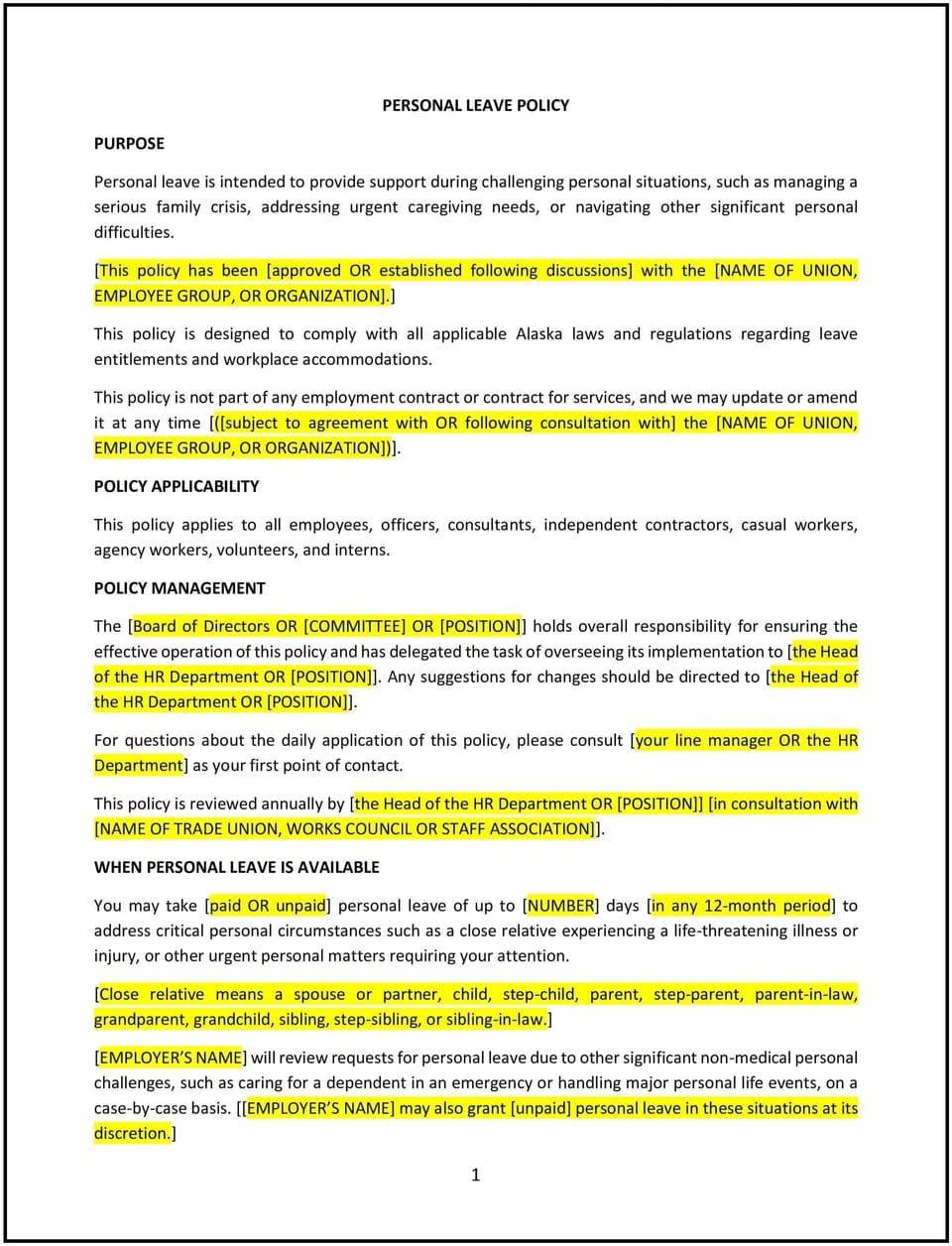Personal leave policy (Alaska): Free template

Personal leave policy (Alaska)
In Alaska, a personal leave policy provides guidelines for employees to request time off for personal reasons, such as attending to family matters, addressing personal health issues, or handling other non-work-related commitments. This policy ensures employees understand the process for requesting leave and the company’s expectations during their absence. By implementing this policy, businesses can support employee well-being while maintaining operational continuity.
How to use this personal leave policy (Alaska)
- Define eligibility: Specify which employees are eligible for personal leave, such as full-time, part-time, or temporary workers, and any conditions that may apply.
- Outline leave duration: Set limits for the duration of personal leave, including whether it is paid, unpaid, or requires using accrued paid time off.
- Include request procedures: Provide a clear process for employees to request personal leave, including advance notice and required documentation.
- Address coverage during leave: Specify how workloads will be managed in the employee’s absence, such as reassigning duties or hiring temporary staff.
- Communicate return-to-work expectations: Include guidelines for employees to inform their managers about their readiness to return and any updates needed.
Benefits of using a personal leave policy (Alaska)
A personal leave policy offers significant advantages for businesses in Alaska. Here’s how it helps:
- Enhances employee well-being: Supports employees in managing personal responsibilities, fostering loyalty and job satisfaction.
- Promotes transparency: Provides clear guidelines for requesting leave, reducing misunderstandings and ensuring fairness.
- Supports operational planning: Helps managers plan for absences and ensure workloads are covered during an employee’s leave.
- Encourages work-life balance: Demonstrates the company’s commitment to supporting employees’ personal and professional needs.
- Reduces disputes: Minimizes conflicts by establishing a structured and consistent approach to personal leave requests.
Tips for using a personal leave policy (Alaska)
- Tailor to workforce needs: Consider the unique needs of your workforce, such as seasonal or remote employees, when defining leave policies.
- Align with other policies: Ensure consistency with related policies, such as vacation, sick leave, or FMLA-related leave.
- Provide flexibility: Where feasible, allow employees to use personal leave for a wide range of reasons to support their individual circumstances.
- Train managers: Equip managers with the tools and knowledge to handle leave requests fairly and effectively.
- Update regularly: Review the policy periodically to reflect changes in workforce needs, company practices, or legal requirements.
Q: Who is eligible for personal leave under this policy?
A: Eligibility depends on employment status, with full-time and part-time employees typically qualifying. Temporary employees may be included at the company’s discretion.
Q: Is personal leave paid or unpaid?
A: Personal leave may be unpaid unless employees use accrued paid time off, such as vacation or sick leave, as permitted by company policy.
Q: How much notice should employees provide when requesting personal leave?
A: Employees should provide as much notice as possible, typically at least two weeks, unless the leave is for an emergency.
Q: How should managers plan for an employee’s absence during personal leave?
A: Managers can reassign duties among team members, hire temporary support, or adjust workflows to maintain operations during the absence.
Q: How often should this policy be reviewed?
A: Review the policy annually or whenever significant changes occur in workforce needs, company operations, or legal requirements.
This article contains general legal information and does not contain legal advice. Cobrief is not a law firm or a substitute for an attorney or law firm. The law is complex and changes often. For legal advice, please ask a lawyer.


